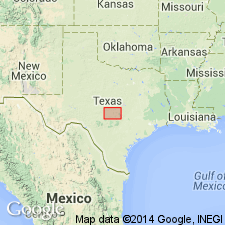
- Usage in publication:
-
- Wayland shale [member]
- Modifications:
-
- Named
- Dominant lithology:
-
- Shale
- AAPG geologic province:
-
- Bend arch
- Fort Worth syncline
Summary:
Named as topmost member of newly named Graham formation of Cisco group (revised). In Colorado River Valley Graham formation is divided into following members (ascending): Bluff Creek shale, Gunsight limestone, and Wayland shale. In Brazos River Valley Graham is divided into following members (ascending): Finis shale and sandstone, Jacksboro limestone, Gonzales Creek shale and sandstone, Bunger limestone, South Bend shale and sandstone, Gunsight limestone, and Wayland shale. No type locality designated. Sections measured. Traced from northern Jack Co (Fort Worth syncline) to Young, Stephens, Eastland, and Brown Cos (Bend arch), in both Brazos and Colorado River Valleys. Underlies Avis sandstone [member] of Thrifty formation (both new) of Cisco in most places. Varies in thickness and in some places is absent, probably due to a local break in sedimentation--in these the overlying Avis sandstone [member] of Thrifty directly overlies Gunsight limestone [member]. Is a very fossiliferous shale, 20-100 ft thick. In the vicinity of Gunsight, Stephens Co, the Wayland contains an astonishing profusion of beautifully preserved fossils, including foraminifers, corals, crinoids, echinoids, bryozoans, brachiopods, gastropods, cephalopods, pelecypods, fish tooth and spine. Fossils listed. Stratigraphic chart. Of Pennsylvanian age.
Source: GNU records (USGS DDS-6; Denver GNULEX).
For more information, please contact Nancy Stamm, Geologic Names Committee Secretary.
Asterisk (*) indicates published by U.S. Geological Survey authors.
"No current usage" (†) implies that a name has been abandoned or has fallen into disuse. Former usage and, if known, replacement name given in parentheses ( ).
Slash (/) indicates name conflicts with nomenclatural guidelines (CSN, 1933; ACSN, 1961, 1970; NACSN, 1983, 2005, 2021). May be explained within brackets ([ ]).

